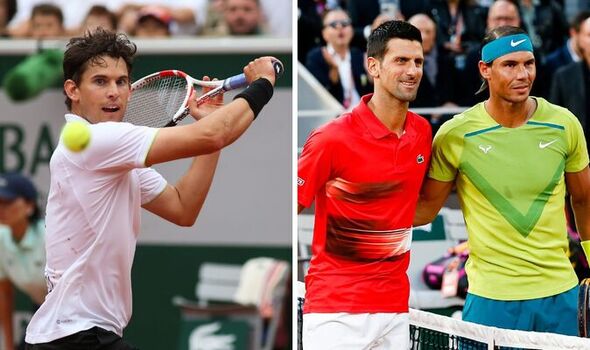
Dominic Thiem’s Injury Woes: A Reflection on the Influence of Rafael Nadal and Novak Djokovic
Dominic Thiem, once heralded as the future of tennis, has found his career increasingly hindered by persistent injury problems. These issues have not only impacted his performance but also raised questions about their origins. While the physical demands of professional tennis are widely recognized, the influence of two of the sport’s greatest players—Rafael Nadal and Novak Djokovic—on Thiem’s current struggles has become a topic of discussion.

Rafael Nadal and Novak Djokovic have long been the benchmarks of excellence in tennis. Their relentless pursuit of success, characterized by extraordinary physical endurance, mental resilience, and unmatched skill, has set a standard that aspiring champions like Thiem have aimed to meet. However, the toll of trying to keep pace with these giants of the game may have contributed to Thiem’s injury challenges.
Nadal, known for his intense, physically taxing style of play, has dominated the clay courts for years. His ability to retrieve seemingly impossible shots and extend rallies has forced his opponents to dig deep, both physically and mentally. Thiem, who has often been seen as Nadal’s heir apparent on clay, has had to push his body to the limits to challenge the Spaniard. The grueling nature of their encounters, particularly in the French Open, where Nadal reigns supreme, has likely played a role in the wear and tear on Thiem’s body.
On the other hand, Novak Djokovic’s influence on Thiem cannot be understated. Djokovic, who has set new standards in terms of physical fitness and flexibility, presents a different kind of challenge. His unparalleled return game, combined with his ability to switch from defense to offense in a blink of an eye, demands that his opponents be in peak physical condition. Thiem, in his quest to break through the Djokovic-Nadal duopoly, has had to adopt training regimens and playing styles that could match Djokovic’s physical and tactical prowess.
The constant need to measure up to Nadal and Djokovic may have inadvertently led Thiem to overexert himself, both in training and during matches. The pressure to compete at their level, coupled with the rigorous demands of the ATP Tour, has likely contributed to the accumulation of physical stress on his body. This stress, over time, manifests in the form of injuries, which have become increasingly frequent for the Austrian star.
Moreover, Thiem’s aggressive style of play, which is essential to contend with players of Nadal and Djokovic’s caliber, has placed additional strain on his body. His powerful groundstrokes and the necessity to engage in long, draining rallies have left him vulnerable to injuries, particularly in his wrist, which has been a recurring issue.
While it is easy to attribute Thiem’s injury problems solely to bad luck or the natural wear and tear associated with professional sports, the indirect influence of Nadal and Djokovic cannot be ignored. Their dominance in the sport has created an environment where younger players feel compelled to push themselves beyond their limits to compete at the highest level. In Thiem’s case, this relentless pursuit of greatness, driven by the standards set by Nadal and Djokovic, may have come at the cost of his physical well-being.
As Thiem continues to navigate his injury challenges, it is worth considering the broader implications of the standards set by Nadal and Djokovic. While their contributions to the sport are undeniable, their influence on the next generation of players raises important questions about the long-term sustainability of the physical demands placed on professional athletes. For Thiem, the road to recovery may involve not just physical rehabilitation, but also a reassessment of the expectations and pressures that have shaped his career thus far.
In conclusion, while Nadal and Djokovic cannot be held directly responsible for Thiem’s injury problems, their dominance in the sport has certainly played a role in shaping the environment that has contributed to his current challenges. As Thiem works towards a comeback, the lessons learned from his experiences may serve as a cautionary tale for the next generation of tennis stars.
Leave a Reply